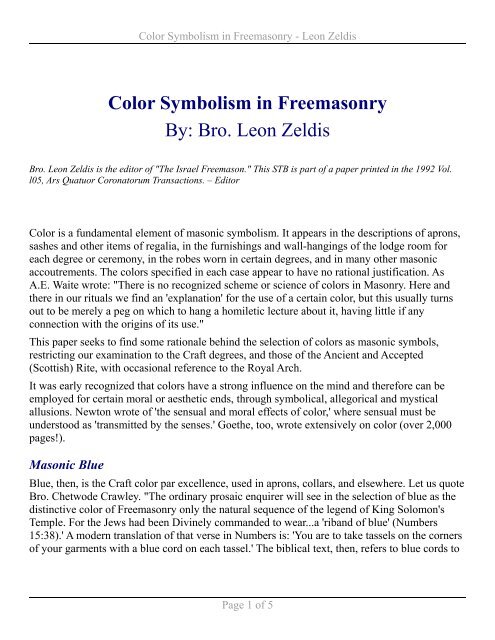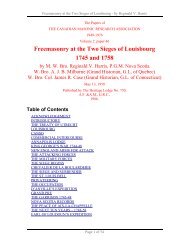Color Symbolism in Freemasonry - Leon Zeldis - Pictou Masons
Color Symbolism in Freemasonry - Leon Zeldis - Pictou Masons
Color Symbolism in Freemasonry - Leon Zeldis - Pictou Masons
Create successful ePaper yourself
Turn your PDF publications into a flip-book with our unique Google optimized e-Paper software.
<strong>Color</strong> <strong>Symbolism</strong> <strong>in</strong> <strong>Freemasonry</strong> - <strong>Leon</strong> <strong>Zeldis</strong><br />
<strong>Color</strong> <strong>Symbolism</strong> <strong>in</strong> <strong>Freemasonry</strong><br />
By: Bro. <strong>Leon</strong> <strong>Zeldis</strong><br />
Bro. <strong>Leon</strong> <strong>Zeldis</strong> is the editor of "The Israel Freemason." This STB is part of a paper pr<strong>in</strong>ted <strong>in</strong> the 1992 Vol.<br />
l05, Ars Quatuor Coronatorum Transactions. – Editor<br />
<strong>Color</strong> is a fundamental element of masonic symbolism. It appears <strong>in</strong> the descriptions of aprons,<br />
sashes and other items of regalia, <strong>in</strong> the furnish<strong>in</strong>gs and wall-hang<strong>in</strong>gs of the lodge room for<br />
each degree or ceremony, <strong>in</strong> the robes worn <strong>in</strong> certa<strong>in</strong> degrees, and <strong>in</strong> many other masonic<br />
accoutrements. The colors specified <strong>in</strong> each case appear to have no rational justification. As<br />
A.E. Waite wrote: "There is no recognized scheme or science of colors <strong>in</strong> Masonry. Here and<br />
there <strong>in</strong> our rituals we f<strong>in</strong>d an 'explanation' for the use of a certa<strong>in</strong> color, but this usually turns<br />
out to be merely a peg on which to hang a homiletic lecture about it, hav<strong>in</strong>g little if any<br />
connection with the orig<strong>in</strong>s of its use."<br />
This paper seeks to f<strong>in</strong>d some rationale beh<strong>in</strong>d the selection of colors as masonic symbols,<br />
restrict<strong>in</strong>g our exam<strong>in</strong>ation to the Craft degrees, and those of the Ancient and Accepted<br />
(Scottish) Rite, with occasional reference to the Royal Arch.<br />
It was early recognized that colors have a strong <strong>in</strong>fluence on the m<strong>in</strong>d and therefore can be<br />
employed for certa<strong>in</strong> moral or aesthetic ends, through symbolical, allegorical and mystical<br />
allusions. Newton wrote of 'the sensual and moral effects of color,' where sensual must be<br />
understood as 'transmitted by the senses.' Goethe, too, wrote extensively on color (over 2,000<br />
pages!).<br />
Masonic Blue<br />
Blue, then, is the Craft color par excellence, used <strong>in</strong> aprons, collars, and elsewhere. Let us quote<br />
Bro. Chetwode Crawley. "The ord<strong>in</strong>ary prosaic enquirer will see <strong>in</strong> the selection of blue as the<br />
dist<strong>in</strong>ctive color of <strong>Freemasonry</strong> only the natural sequence of the legend of K<strong>in</strong>g Solomon's<br />
Temple. For the Jews had been Div<strong>in</strong>ely commanded to wear...a 'riband of blue' (Numbers<br />
15:38).' A modern translation of that verse <strong>in</strong> Numbers is: 'You are to take tassels on the corners<br />
of your garments with a blue cord on each tassel.' The biblical text, then, refers to blue cords to<br />
Page 1 of 5
<strong>Color</strong> <strong>Symbolism</strong> <strong>in</strong> <strong>Freemasonry</strong> - <strong>Leon</strong> <strong>Zeldis</strong><br />
be <strong>in</strong>corporated <strong>in</strong> the tassels worn by pious Jews, while Bro. Chetwode Crawley is speak<strong>in</strong>g of<br />
blue ribbons which somehow became the embellishments of aprons, sashes and collars.<br />
Another suggested source of the color mentioned by Bro. Chetwode Crawley could be its<br />
association with St. Mary, mother of Jesus, 'so prom<strong>in</strong>ent a figure <strong>in</strong> the pre-Reformation<br />
<strong>in</strong>vocations of the Old Charges, draw<strong>in</strong>g <strong>in</strong> her tra<strong>in</strong> the red ensign of St. George of<br />
Cappadocia, her steward and our Patron Sa<strong>in</strong>t.'<br />
Blue and red, the heraldic azure and gules are sometimes associated with the chevron of the<br />
Arms of the <strong>Masons</strong>' Company.<br />
The Masonic <strong>Symbolism</strong> of <strong>Color</strong>s<br />
a) White<br />
White, the orig<strong>in</strong>al color of the masonic apron, was always considered an emblem of purity and<br />
<strong>in</strong>nocence, exemplified <strong>in</strong> images such as the white lily or fallen snow.<br />
Plato asserts that white is par excellence the color of the gods. In the Bible, Daniel sees God as<br />
a very old man, dressed <strong>in</strong> robes white as snow (Daniel 7:9). In the New Testament Jesus is<br />
transfigured on Mount Tabor before Peter, James and John, when his clothes became 'dazzl<strong>in</strong>g<br />
white, whiter than anyone <strong>in</strong> the world could bleach them' (Mark 9:3). Officiat<strong>in</strong>g priests of<br />
many religions wore and still wear white garments. In ancient Jerusalem both the priests and the<br />
Levites who performed the Temple rites assumed white cloth<strong>in</strong>g.<br />
Among Romans, the unblemished character of a person aspir<strong>in</strong>g to public office was <strong>in</strong>dicated<br />
by a toga whitened with chalk. This is the orig<strong>in</strong> of the word 'candidate,' from candidatus<br />
'dressed <strong>in</strong> white.' Verdicts at trials were decided by small stones (calculi) thrown <strong>in</strong>to an urn:<br />
white to absolve, black to condemn.<br />
White signifies beg<strong>in</strong>n<strong>in</strong>gs, virtualities, the white page fac<strong>in</strong>g the writer, 'the space where the<br />
possible may become reality.' White is therefore understandably the color of <strong>in</strong>itiation. It is a<br />
symbol of perfection, as represented by the swan <strong>in</strong> the legend of Lohengr<strong>in</strong>. In this aspect it is<br />
related to light or sky blue, which <strong>in</strong> Hebrew is tchelet and may be connected semantically with<br />
tichla (perfection, completeness) and tachlit (completeness, purpose). (See also the observations<br />
on the symbolism of blue.) Among the Celts the sacred colors of white, blue and green were<br />
understood to stand for light, truth and hope. Druids were robed <strong>in</strong> white.<br />
White is also connected with the idea of death and resurrection. Shrouds are white; spirits are<br />
represented as wear<strong>in</strong>g white veils. White, rather than black, is sometimes the color of<br />
mourn<strong>in</strong>g, among the ancient k<strong>in</strong>gs of France, for <strong>in</strong>stance, and <strong>in</strong> Japan. White, f<strong>in</strong>ally, can<br />
signify joy. Leukos (Greek) means both white and cheerful; as does candidus <strong>in</strong> Lat<strong>in</strong>. The<br />
Romans marked festive days with lime and unlucky days with charcoal.<br />
Page 2 of 5
) Blue<br />
<strong>Color</strong> <strong>Symbolism</strong> <strong>in</strong> <strong>Freemasonry</strong> - <strong>Leon</strong> <strong>Zeldis</strong><br />
Blue is the color of the canopy of heaven: azure, cerulean or sky blue. 'Universally, it denotes<br />
immortality, eternity, chastity, fidelity; pale blue, <strong>in</strong> particular, represents prudence and<br />
goodness.' In the Royal Arch, the Third Pr<strong>in</strong>cipal is told that it is an emblem of beneficence and<br />
charity.<br />
In biblical times, blue was closely related to purple. Generations of scholars have puzzled over<br />
the correct mean<strong>in</strong>g of tchelet (light blue) and argaman (purple), usually mentioned together,<br />
without reach<strong>in</strong>g satisfactory conclusions. Only recently has the problem been f<strong>in</strong>ally solved <strong>in</strong><br />
the course of far-reach<strong>in</strong>g research <strong>in</strong>to the dyestuffs and dye<strong>in</strong>g methods used by the ancient<br />
Phoenicians and Hebrews. Both colors, it turns out, were produced with dye<strong>in</strong>g materials<br />
extracted from murex, a shellfish abundant on the coast of Lebanon. The tchelet was obta<strong>in</strong>ed<br />
from a short-variety (murex trunculus); the argaman came from two k<strong>in</strong>ds: the s<strong>in</strong>gles-p<strong>in</strong>ed<br />
murex brandaris and, to a lesser extent, the Red-mouth (thais haemastoma).<br />
Some historians have concluded that, <strong>in</strong> the Middle Ages <strong>in</strong> Europe, blue was low <strong>in</strong> popular<br />
esteem. The favorite color was then red because the dyers could achieve strong shades of it<br />
which brought to m<strong>in</strong>d the prestigious purple of the ancient world. Towards the end of that<br />
period, blue gradually became recognized as a pr<strong>in</strong>cely color, the 'Royal Blue' which displaced<br />
red at court, red then be<strong>in</strong>g used by the lower classes and so regarded as vulgar. Blue and gold<br />
(or yellow) then became the colors of choice for shields, banners and livery.<br />
It may not be by chance, therefore, that the Master was said to be clothed <strong>in</strong> 'yellow jacket and<br />
blue breeches,' <strong>in</strong> the famous metaphor first used <strong>in</strong> an exposure, 'The Mystery of <strong>Freemasonry</strong>,'<br />
which appeared <strong>in</strong> The Daily Journal <strong>in</strong> 1730. The traditional explanations of the phrase relate it<br />
to the compasses, the arms of gold, gilt or brass and the po<strong>in</strong>ts of steel or iron. (Steel can<br />
certa<strong>in</strong>ly appear blue; iron can not!)<br />
Blue was used royally <strong>in</strong> France noticeably as the background to the fleur-de-lys. It became<br />
associated with terms of prestige such as blue blood, cordon bleu (orig<strong>in</strong>ally the sash of the<br />
Order of the Holy Spirit), blue riband (of the Atlantic) and blue chip.<br />
c) Purple<br />
Purple is a symbol of imperial royalty and richness but can also relate to penitence and the<br />
solemnity of Lent and Advent <strong>in</strong> the seasons of the Christian church.<br />
Although described (<strong>in</strong> the Royal Arch, for <strong>in</strong>stance) as 'an emblem of union, be<strong>in</strong>g composed<br />
of blue and crimson,' I believe this to be a somewhat contrived explanation. But an <strong>in</strong>terest<strong>in</strong>g<br />
fact, which appears to have escaped most writers on this subject, is that <strong>in</strong> the Cabbala, the<br />
Hebrew word for purple, argaman, is a mnemonic, represent<strong>in</strong>g the <strong>in</strong>itials of the names of the<br />
five pr<strong>in</strong>cipal angels <strong>in</strong> Jewish esoterism.<br />
Page 3 of 5
d) Red<br />
<strong>Color</strong> <strong>Symbolism</strong> <strong>in</strong> <strong>Freemasonry</strong> - <strong>Leon</strong> <strong>Zeldis</strong><br />
Red or crimson, the color of fire and heat, is traditionally associated with war and the military.<br />
In Rome the paludamentum, the robe worn by generals, was red. The color of blood is naturally<br />
connected with the idea of sacrifice, struggle and heroism. It also signifies charity, devotion,<br />
abnegation – perhaps recall<strong>in</strong>g the pelican that feeds its progeny with its own blood.<br />
In Hebrew, the name of the first man, Adam, is ak<strong>in</strong> to red, blood and earth. This connection<br />
with earth may expla<strong>in</strong>, perhaps, the connection of red with the passions, carnal love, the<br />
cosmetics used by women to attract their lovers. It is the color of youth. Generally, it represents<br />
expansive force and vitality. It is the emblem of faith and fortitude and, <strong>in</strong> the Royal Arch, of<br />
fervency and zeal. It has also a darker side, connected with the flames of hell, the appearance of<br />
demons, the apoplectic face of rage.<br />
Scarlet was the dist<strong>in</strong>ctive color of the Order of the Golden Fleece, established <strong>in</strong> 1429 by<br />
Philip the Good, Duke of Burgundy (1419-67). Not only was the mantle scarlet, but also the<br />
robe and a special hat – the chaperon – with hang<strong>in</strong>g streamers.<br />
e) Green<br />
Green has been directly associated with the ideas of resurrection and immortality… The acacia<br />
(the masonic evergreen) has been suggested as a symbol of a moral life or rebirth, and also of<br />
immortality. To the ancient Egyptians, green was the symbol of hope.<br />
The Grand Lodge of Scotland has adopted green as its emblematic color, and, <strong>in</strong> vary<strong>in</strong>g shades,<br />
it is <strong>in</strong>corporated <strong>in</strong> the dress and furnish<strong>in</strong>gs of degrees and Orders beyond the Craft <strong>in</strong><br />
English, Irish and Scottish <strong>Freemasonry</strong>.<br />
f) Yellow<br />
Yellow is rarely seen <strong>in</strong> lodge, except perhaps on the Cont<strong>in</strong>ent. It is an ambivalent color,<br />
represent<strong>in</strong>g both the best and the worst, the color of brass and honey, but also the color of<br />
sulphur and cowardice. Yellow is the perfection of the Golden Age, the priceless quality of the<br />
Golden Fleece and the golden apples of the Hesperides. It is also the color of the patch imposed<br />
on the Jews as a badge of <strong>in</strong>famy. In the sixteenth century, the door of a traitor's home was<br />
pa<strong>in</strong>ted yellow. A 'jaundiced view' expresses hostility, but the most memorable symbolism of<br />
yellow is that it rem<strong>in</strong>ds us of the sun and of gold.<br />
g) Black<br />
The three fundamental colors found <strong>in</strong> all civilizations, down to the Middle Ages <strong>in</strong> Europe, are<br />
white, red and black. These, too, may be regarded as the pr<strong>in</strong>cipal colors of <strong>Freemasonry</strong>: the<br />
white of the Craft degrees, the red of the Royal Arch and of certa<strong>in</strong> of the degrees of the Ancient<br />
Page 4 of 5
<strong>Color</strong> <strong>Symbolism</strong> <strong>in</strong> <strong>Freemasonry</strong> - <strong>Leon</strong> <strong>Zeldis</strong><br />
and Accepted (Scottish) Rite, and the black of some of its others, and of the Knights of Malta.<br />
The other colors of the ra<strong>in</strong>bow f<strong>in</strong>d limited uses; they serve only to frame or l<strong>in</strong>e the white<br />
lambsk<strong>in</strong> upon which so many aprons are based, or for sashes and other items of regalia.<br />
Traditionally, black is the color of darkness, death, the underworld although it was not<br />
<strong>in</strong>troduced for mourn<strong>in</strong>g until about the middle of the fourteenth century, such use becom<strong>in</strong>g<br />
habitual only <strong>in</strong> the sixteenth. The 'black humor' of melancholy (atara hilis) the black crow of ill<br />
omen, the black mass, black market, 'black days': all refer to negative aspects. The Black Stone<br />
at Mecca is believed by Muslims to have been at one time white; the s<strong>in</strong>s of man caused the<br />
transformation.<br />
Black has also a positive aspect, that of gravity and sobriety; the Reformation <strong>in</strong> Europe<br />
frowned upon colorful cloth<strong>in</strong>g. Formal dress for day and even<strong>in</strong>g wear cont<strong>in</strong>ues to be black. It<br />
is associated with the outlaw and the banners of pirates and anarchists, but also with rebirth and<br />
transformation.<br />
In the French and Scottish Rites, the lodge <strong>in</strong> the third degree is decorated <strong>in</strong> black and is<br />
strewn with white or silver tears, represent<strong>in</strong>g the sorrow caused by the death of Hiram Abif.<br />
Conclusion<br />
A review of the traditional explanations for the choice of certa<strong>in</strong> colors <strong>in</strong> masonic symbolism<br />
reveals their weaknesses. In consider<strong>in</strong>g the use of blue <strong>in</strong> the English regalia of a Master<br />
Mason, it has been possible to f<strong>in</strong>d a connection between one of the Hebrew words for that<br />
color and the Holy Bible.<br />
STB - April 1994<br />
Page 5 of 5



![The Meaning of Masonry [pdf]. - Pictou Masons](https://img.yumpu.com/11675772/1/190x245/the-meaning-of-masonry-pdf-pictou-masons.jpg?quality=85)


